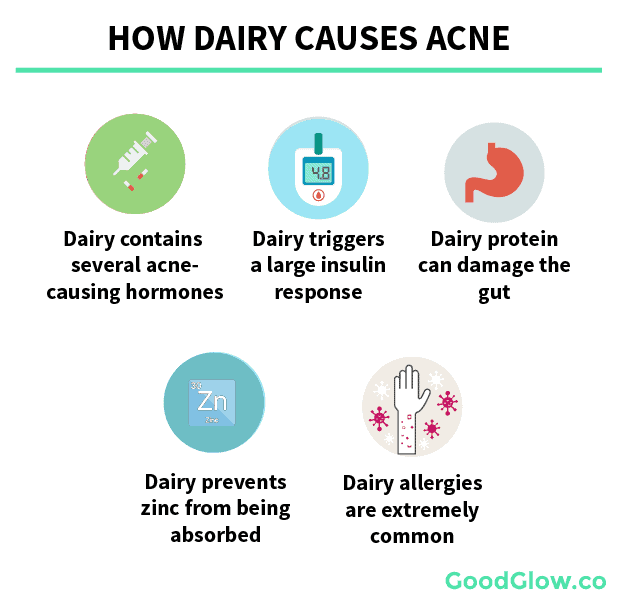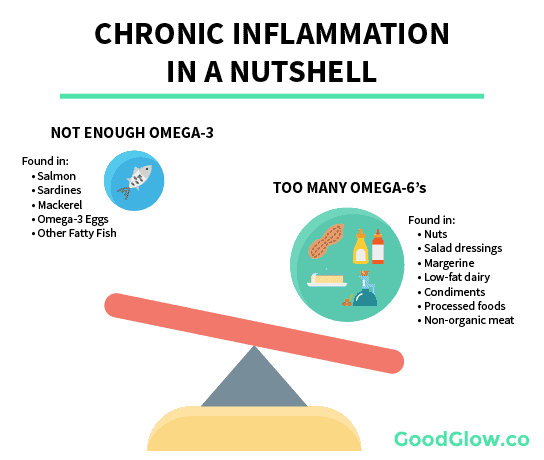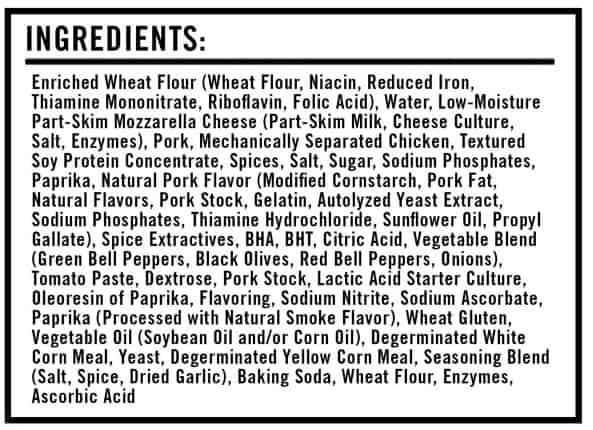Have you ever eaten a greasy, cheesy, savory pizza and found yourself breaking out the next day?
Well, there are several good reasons why – and it’s not just because “greasy food causes acne”.
Pizza is one of the worst foods to eat for acne-prone skin for a few reasons – it contains a significant amount of dairy, which has hormones that overstimulate skin oil production and can trigger inflammatory acne. It also contains gluten, which can damage the gut and lead to even more acne, and unhealthy fats that can trigger inflammation. Finally, pizza is high in carbohydrates, which triggers the body to release even more acne-causing hormones.
Overall, pizza hits just about every possible root cause of acne – digestive, hormonal, and inflammatory acne.
Pizza, dairy, and acne
Unless you’re getting a Vegan or dairy-free pizza, odds are you’re going to be consuming a lot of low-quality cheese anytime you eat pizza.
Cheese is likely to cause acne for a few reasons:
- Dairy contains hormones (IGF-1) that clog and block pores
- Most dairy triggers a large insulin (an acne-causing hormone) response (so it’s double trouble for hormonal acne)
- Dairy protein (casein) can damage the digestive system
- Dairy is high in calcium, which prevents zinc, a crucial nutrient for clear skin, from being absorbed
- Many people are allergic or intolerant to dairy, which can cause inflammatory acne
Pizza typically contains pasteurized, soft, young cheese from cows, which is some of the worst for acne.
Aged, hard, raw cheese from goats or sheep are lower in acne-causing hormones like IGF-1 and easier to digest than most of the cheese you’ll find on pizza. The downside? It usually isn’t as tasty as fresh mozzarella.
Pizza, grease, and inflammatory acne
If you’re like me, your mom probably told you:
“Don’t eat greasy foods, it’ll give you acne!”
While this isn’t entirely true, and there are plenty of reasons why some fat is actually great for acne-prone skin, there is some truth to it when it comes to foods like pizza.
Artificial foods like pizza contain vegetable oils, including soybean, sunflower, safflower, and canola oil. The problem with these oils is that they are extremely unstable, especially under high heat. When these oils get cooked, they turn into highly-inflammatory fats. Inflammation is what takes a simple little acne infection and turns it into a bright, red, protruding pimple.
A single slice of pizza has around 1.36g of omega-6 fatty acids.
That’s quite a bit by itself, but ask yourself this: when’s the last time you had just one slice of pizza?
Pizza, gluten, and acne
Gluten, which is a protein found in wheat and many other grains, is a pretty big problem for acne.
Pizza crust is loaded with gluten.
Gluten is what’s known as a lectin. Lectins are compounds found in plants that prevent animals from digesting them properly. Our bodies aren’t able to break down certain lectins, so they enter the small intestine undigested and can punch holes in the intestinal wall. This can lead to a condition called leaky gut syndrome.
Leaky gut syndrome is a problem for acne for a few reasons: first, it allows undigested protein to enter the bloodstream. When this happens, your immune system fires off an inflammatory response. If this happens too much, it can lead to a hyperactive immune system that triggers inflammatory acne. It also can lead to hormonal acne through insulin resistance, and prevent your body from absorbing acne-fighting nutrients like zinc.
In summary, gluten damages the digestive system by making it easier for undigested food to pass through your gut into your bloodstream. This can trigger inflammatory and hormonal acne.
Pizza is no exception, as the majority of pizza crusts are loaded with gluten.
For more details on gluten, read this guide on the impact of gluten to acne.
Pizza, carbs, and acne
Pizza is pretty high in carbs, with a single slice contains 23.5g of carbs.
Carbs aren’t evil, and they won’t automatically cause acne, but too many carbs too frequently will.
When you eat carbs, your body releases a hormone known as insulin to help break the carbs down and transport them to the muscles that need them. When you eat too many carbs too often, your body becomes insulin resistant. Just like how you need more and more coffee to feel energized every morning your body needs more and more insulin to move carbs around.
This is bad for acne because insulin doesn’t work alone – it’s a master hormone that triggers the release of three other acne-causing hormones:
- IGF-1 -increases skin oil production, blocks pores, and promotes inflammation
- IGFBP-3 – clogs and blocks pores
- IL-1 – promotes inflammation
These three hormones trigger pretty much every root cause of acne.
If you’re having 3 or 4 slices of pizza, that’s a pretty big insulin response. Granted pizza isn’t the world’s largest source of carbs, it’ll still make a dent.
See my guide to Carbs, Sugar, Insulin, and Acne for more details.
Pizza, additives, and acne
Okay, this is a more minor point, but have you ever looked at the ingredients list for a frozen pizza? Here’s a snapshot of one popular brand:
Wow, yeah, not so great, I can spot a dozen or so added ingredients that are known to be problematic for acne right off the bat…
- Enriched wheat flour
- Skim mozzarella cheese
- Soy protein concentrate
- Cornstarch (modified)
- Yeast extract
- Gluten
- Soybean oil
- Corn oil
- Corn meal
Yikes, not great – unless you’re in Europe, odds are your pizza is going to have a massive ingredients list with tons of acne-causing additives – not a good play for your skin.
“Will pizza always give me acne?”
At this point, you’re probably wondering if it’s ever safe to have pizza again when it comes to acne. Here’s the deal – everyone is different. Some people might be able to handle certain types of kinds of pizza, while others may not.
Personally, I can’t handle pizza in the United States because the cheese is grain-fed, low-fat, and pasteurized, the crust is enriched and high in gluten, and there are tons of additives. In Italy, I don’t seem to have a problem with the occasional high-quality pizza (the cheese is almost always raw buffalo cheese, the grain is much lower in gluten, and the ingredients are fresh, local, and often organic).
You might be able to handle some pizzas, but not others – some of you might have to cut it out altogether and try adding it back later. There is no one-size-fits-all.
With that being said, there are some ways to make your pizza considerably more acne-friendly.
How to make your pizza more acne-friendly
There is no perfect pizza for acne – but there are certainly better pizzas for your skin than your typical frozen or delivery pie.
Here are a few tips to get started:
- Go for a gluten-free crust – try to use coconut flour or a cauliflower crust instead of grain. Most places will have a gluten-free crust option that uses eggs, nuts, coconut, or cauliflower.
- Use better cheese – use a raw (unpasteurized), aged, sheep or goat cheese if possible. These cheeses are lower in hormones (IGF-1) and easier to digest
- Make your own tomato sauce – a lot of tomato sauces are filled with vegetable oils and sugar – instead, make one with real tomatoes and use olive oil instead of vegetable oils
Again, it’s not going to be perfect, but making your own pizza, or even just substituting with a gluten-free crust can make a world of difference.
Frequently Asked Questions
Most store-bought tomato sauces are inflammatory because they contain high sugar and vegetable oil content. If you are buying or making your own tomato sauce make sure to use olive oil and avoid adding sugar or processed tomatoes.
Pizza is high in carbs, sugar, and dairy which all spike the glucose levels and are highly correlated with acne breakouts. Additionally, eating lots of dairy can slow down collagen production which makes it more difficult for acne to clear up.




